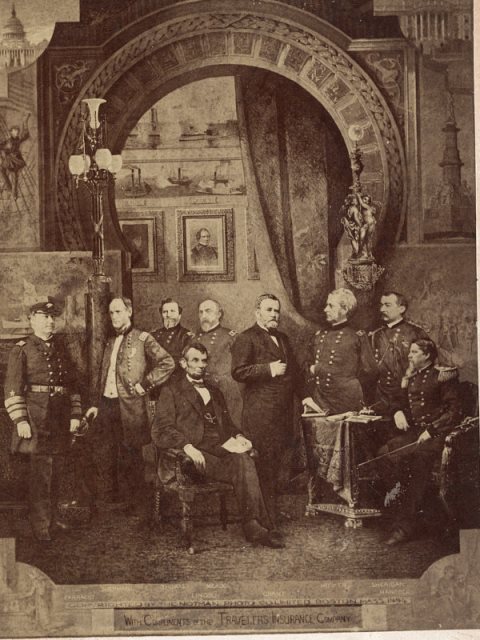A 19th century insurance advertisement from
Travelers Life and Accident Insurance Co. is causing quite a stir at the Library of Congress this week.
Presented “with compliments” from Travelers, the ad contains a portrait of President Abraham Lincoln surrounded by Civil War heroes like Admiral David G. Farragut and Generals William T. Sherman, George Henry Thomas, George Gordon Meade, Ulysses S. Grant, Joseph Hooker, Philip Henry Sheridan and Winfield Scott Hancock.

It’s a handsome portrait, but a closer inspection reveals one vital flaw – it’s completely made up. The photo is dated by the Library to 1884, when Lincoln had been dead for 19 years and several others had also died.
Mary Beth Davidson, director of records and information management with Travelers, told NPR that the insurer had actually had two doctored photographs created in 1883: one of Northern commanders and one of Southern commanders. The photos were meant “for advertising purposes and [were] given to our agents for display or distribution to customers.”
The photo-artist “used individual photographs of the Confederate commanders and created a composite picture of them together,” Davidson said. “The figures were cut from the print and pasted on a painted background. The process would be similar to using software like Photoshop in today’s terms to place images together in one photo.”
Davidson said the idea of using the photos as an advertisement came from Major Edward Preston, the Travelers superintendent of agencies.
“The first copy of the ‘Confederate Commanders’ was delivered to Jefferson Davis by the Travelers representative in Montgomery, Alabama. Copies also were sent to all the living generals in both pictures,” she said.
The campaign proved so successful, Travelers created a number of other photo composites, including “Famous American Authors,” “Eminent Women” and “Famous Editors.”
The ad and its doctored photo came to attention after NPR posted a story about another montage at the Library of Congress called “Ulysses S. Grant at City Point.”
Historians said the use of such montages were not considered “trick” photography at the time, but rather thought to be art conveying a message or looking to provide the “best image.”


